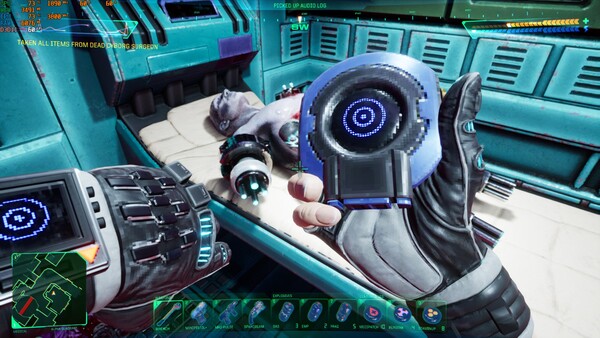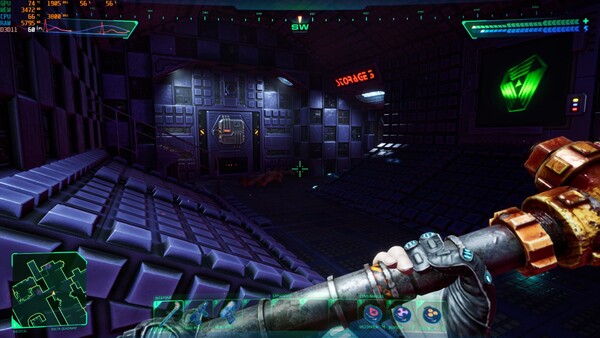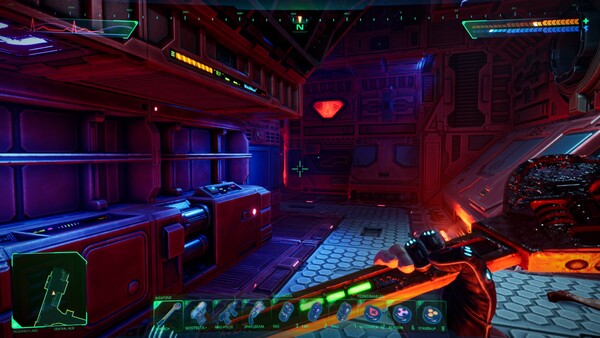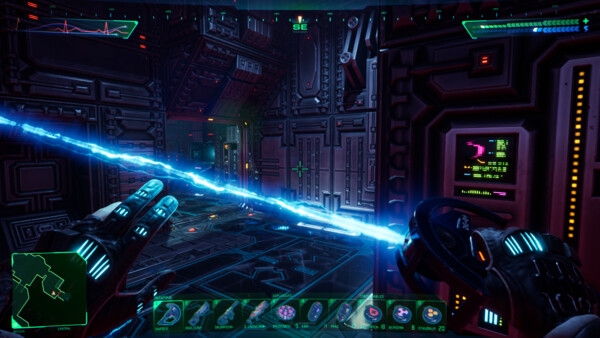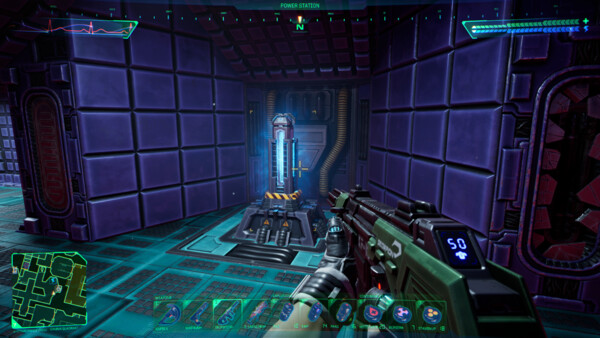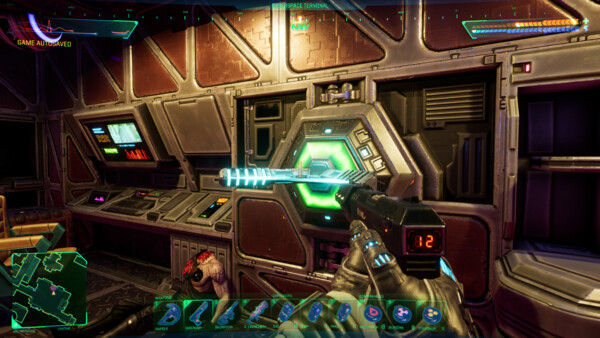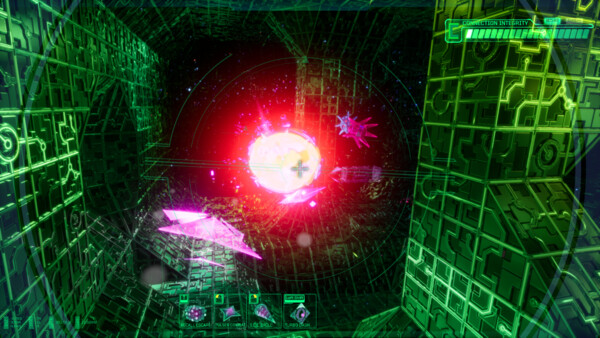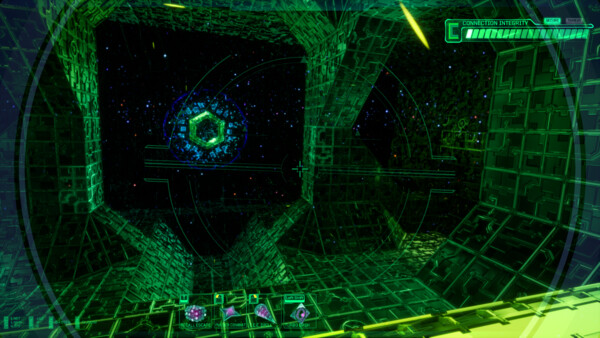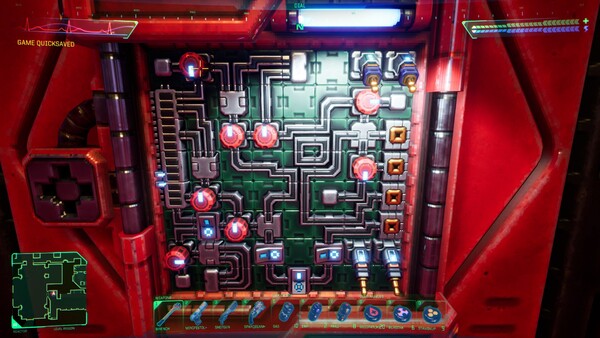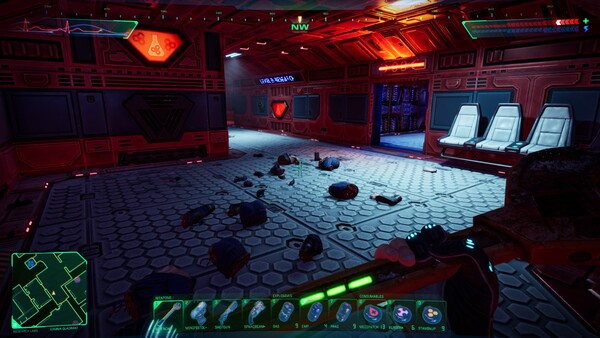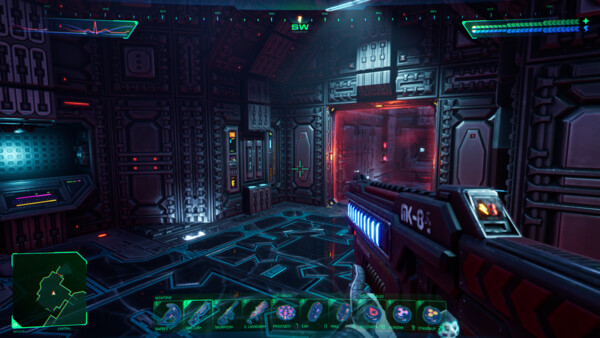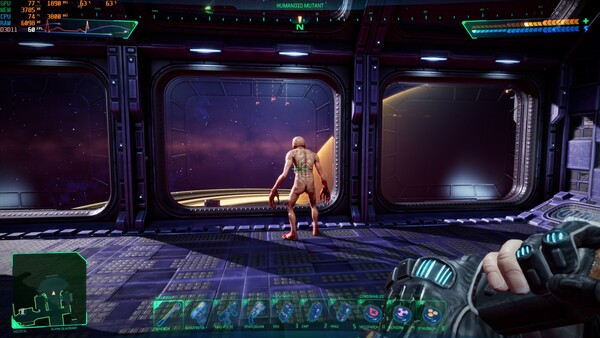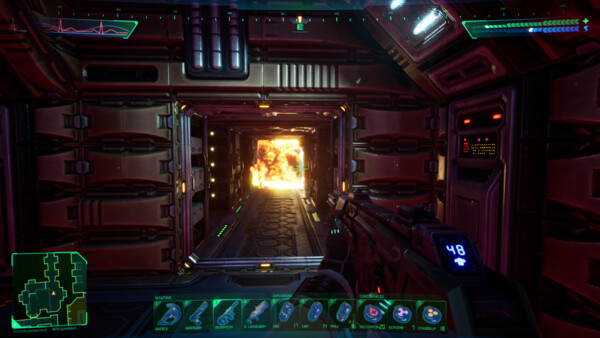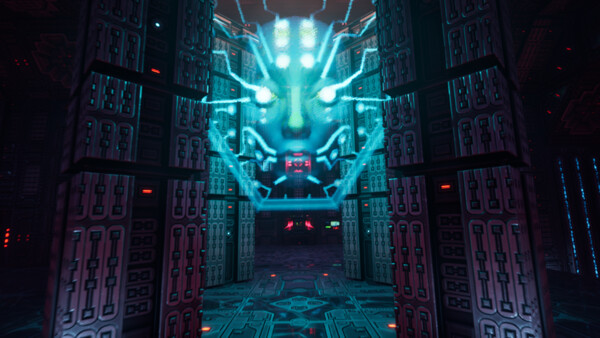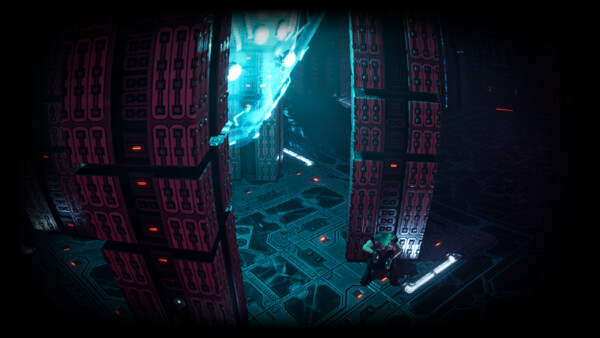System Shock remake
System Shock is a franchise that has been very influential artistically and at the same time not a great commercial success. Since the latter is the more important factor in deciding which games get made it is no surprise that up until recently we’ve only seen two entries in the series: the original System Shock from 1994 and its sequel System Shock 2 from 1999. That has recently changed with the release of the long awaited System Shock remake, which I finished playing a few evenings ago.
Before I talk about the remake let’s quickly revisit two previous games and why they were important. System Shock games belong to the immersive sim genre, which is typically characterized by non-linear gameplay combined with emphasis on exploration, permitting players to solve problems in different ways (e.g. direct confrontation vs. stealth), and RPG elements1. In addition to that, System Shock is a cyberpunk survival horror where you face a rogue AI known as SHODAN, possibly one of the most known villains in video gaming. Other immersive sims you might have heard about are the first Deus Ex, BioShock (a spiritual successor to System Shock that has been both critically and financially successful), and Dishonored.
To me personally System Shock is an important series, though I somewhat feel I am not entitled to saying this. That’s because I didn’t really play the first System Shock. As for System Shock 2 I never finished it despite several attempts at doing so, including a co-op one over the network some 20 years ago. SS2 was just too difficult for me, the main problem being enemies that kept respawning if one did not move forward quickly enough. I remember having my ammo supplies depleted and attempting to fight my way through with melee weapons, which at some point was just not possible since enemies were too tough. But despite these failures at completing the game I spent many hours with it, and its cyber-horror atmosphere was very influential on me. It got me to name my computers after rogue AIs from science-fiction works, a habit that I’ve been faithful to for the past two decades and including well-known characters like SHODAN or GLaDOS, as well as more obscure ones such as WAU.
Short history of long development
Let’s quickly talk about how the System Shock remake came to be. It was first announced to the public in 2016, when a Kickstarter campaign was launched by Nightdive Studios to fund the development. Importantly, the campaign was accompanied by a playable demo of the game that demonstrated that the team has both a vision of what the game should be as well as skills needed to bring that vision to life. All it needed was time and money. System Shock is a beloved franchise for many and the campaign ended in a success, totalling 1.35M dollars out of 0.9M dollars requested, exceeding the requested funds by a 50% margin. Funding was secured, vertical slice already implemented and the release date set for late 2017 ‒ what could possibly go wrong?
Apparently, a lot. I feel the development history of System Shock remake will be written about in books2. A brief summary is that the team attempted to expand the scope of the project and ran out of money. Development was put on hold, with Nightdive Studios searching for partners that would help fund the game. System Shock missed seven release dates. Some of them in a very bad style with announced date passing without a single word from the developer about yet another delay. These delays as well as other things that happened during development have been detailed by user Shoot Man on GOG.com forums here. Despite the predictions of some that claimed the game will never see a release, System Shock remake was finally released in May 20233. I am happy to say that despite troubled development it is a very good game.
A great immersive sim
In System Shock you play as the Hacker. After a short opening sequence ‒ which, by the way, I found confusing, having trouble figuring out what I need to do in the first room ‒ you wake up on the Medical deck of Citadel, a space station orbiting Saturn. You need to make your way through the station decks all the way to the bridge to stop the rogue AI SHODAN. What is beautiful about System Shock is lack of any explicit mission objectives and mission markers that would guide you by hand. It is up to you to explore the environment and piece together transmissions from few survivors on the station as well as audio logs of those who did not survive. In the end you are left with knowledge of what to do and it is up to you to find the required items and places where to make use of them.
The beginning of the game is difficult. You are short on ammo so getting through the initial decks requires relying heavily on basic melee weapons, pipe and wrench.
Later these get replaced by a powerful Laser Rapier, which is one of the best weapons in the game. Its only downside is the fact that it’s a melee weapon, forcing you to get in close quarters with the enemy. This weapon is identical in spirit to Dragon’s Tooth sword from the first Deus Ex game.
Early in the game there’s also a shortage of healing items. You will find yourself backtracking very often to a surgery machine found in Medical to get your health fully restored.
At this point it should be clear that System Shock is not a first-person shooter. Yes, it has a first-person perspective. Yes, there is shooting. But this is not a game where you keep moving forward, ploughing through dozens of enemies while shooting left and right. Ammo tends to be in short supply and that always made me think twice before firing. Do I really need to shoot, or is there a more resource-efficient way of disposing of an enemy?
Unlike many immersive sims, System Shock doesn’t really have significant RPG elements. You will find cybernetic upgrades throughout the game, ones that allow you to move faster, jump higher, withstand radiation, etc. But that’s as far as character progression goes. The only choices that you get to make that influence your playing experience are weapons. There are several types of hand arms, rifles, and heavier weapons, as well as mines and grenades. Additionally, most weapons have two ammo types or firing modes, as well as upgrades. This allows for a variety of play styles and tactics that can be employed against enemies. However, inventory space is limited and each weapon takes up space in that inventory. There is no way to carry every single weapon that you come across, especially given that ammo also takes up space. Hard choices have to be made and some weapons will get left behind. My standard armament was the DG-04 Laser Rapier, Magnum 2100 Pistol (I ended up running out of ammo for it towards the end of the game), KF-18 Scorpion SMG, and, last but not least, EM-83 Grenade Launcher for dealing with heavy stuff. The grenade launcher is especially powerful when combined with EMP grenades, which can disable every enemy (including bosses!) for several seconds.
Backtracking is an essential element of System Shock experience. Levels will be traversed back and forth, and revisited many times. Since the game does not guide you by hand, you also have a certain degree of freedom about the order in which to explore the decks. The first deck is Medical, followed by Research. From Research you can go either to the Reactor ‒ that was my choice, though I think I might have made the game slightly more difficult for myself ‒ or Maintenance. Maintenance deck is the closest you’ll get to a central hub in System Shock. From it you can go further to Storage, Flight Deck, or Executive. Executive level provides access to remaining decks of Engineering, Security and the Bridge, which are traversed in linear order, with Security being the point of no return. Certain enemies will respawn, so backtracking isn’t entirely stress-free. However, game balance is much better than in System Shock 2, so you don’t run the risk of completely running out of ammo4. Also, most decks will have a respawn station that you can unlock to have your body rebuild when you die, allowing for infinite attempts at beating through the enemies, even if it’s only with a wrench. In fact at an early point in the game, at the Reactor deck, I had to resort to this technique. This was one point of the game that I found quite tedious and regretted my choice of difficulty settings.
System Shock allows you to adjust the difficulty of four aspects of the game: combat, mission, puzzles and cyberspace. (More on the latter two in a moment.) Unfortunately, these settings can only be selected when starting a new game and cannot be changed later. As usual I went with medium settings and at several points in the game I regretted not going with easier combat. Having played through the game though I have a feeling of satisfaction and think that combat wasn’t really that tough for most of the time, and a few difficulty spikes make it all the more memorable.
Aside from combat you will encounter two other types of challenges. First one is cyberspace. Throughout Citadel station there are cyberspace terminals that transport you to a gravity-less 3D cyberspace, where you can move freely and have to fight waves of enemies. (Remember Descent?) The goal is to destroy large crystals hidden inside, which typically results in opening previously locked doors in the real world.
Second type of challenges you’ll encounter are hacking puzzles. These come in two types. One requires rewiring a power board to deliver the desired power output. There are switches to redirect or cut off a path of energy, sum gates that add powers of incoming signals and multiplexer gates that split one path into two while retaining the power. The other type of puzzle requires connecting two buttons by rotating pipes located on the board. It took me a moment to figure out how these puzzles work, but once I grasped the basic rules most were fairly simple.
As you might have already noticed, System Shock remake goes for a unique art style, combining low-resolution environment textures with modern dynamic lighting. This works extremely well and results in a visually stunning experience. If there is anything I could complain about when it comes to the graphics it would be the lack of diversity in dead crew models. It feels like every dead person looks exactly the same. That’s not a thing that hinders playing experience in any way, but could have been done better.
Sadly, I can’t give the audio side of the game as much praise. Firstly, the soundtrack is lacklustre. The music isn’t bad, but isn’t exceptional either. Having spent probably over 15 hours in the game the only piece of music that I can now remember is a jingle played in the lift when moving between levels. The way the game switches between exploration and combat music is poorly executed. Combat music kicks in 3-4 seconds after starting combat, but in many cases the enemy is already dead by that time. So the combat music starts playing after combat has taken place and keeps playing for 10-15 more seconds even though there is no threat nearby. This is very confusing leading to a complete discord between music and the in-game events. Other problems with the sound are related to noise made by enemies. The way sound is implemented makes it very difficult to determine enemy location from the noise they are making. In particular, in some places enemies can be heard through the walls in ways that should absolutely be impossible in the real world. All in all, both music and environment sounds should support what is being displayed on the screen, but in System Shock they really don’t, which is a shame.
One last complaint I am going to make is about the ending, which is practically non-existent and very disappointing. I am going to spoil it in this paragraph, though there isn’t really much to spoil. So you make your way through the Bridge deck, killing SHODAN’s minions, and reaching the final cyberspace. That one cyberspace is a special one: you don’t float freely, but rather walk with a weapon. There is no usual health bar. You can die, but if that happens you are immediately respawned and allowed to continue. In other words you can’t fail. This in itself isn’t bad ‒ symbolic fight with the final boss can be a good way of telling a story. Once you destroy a large something in cyberspace (I have no clue what that is) you are taken out of cyberspace to witness SHODAN changing her colour from green to blue (presumably her moral restraints being re-instantiated?). Then the Hacker just sits next to SHODAN, tired and exhausted. And that’s really it. SHODAN, who has been a looming, threatening presence throughout the game, stays completely silent. Even as you make your way through the bridge she barely says anything. She no longer mocks or threatens you, and makes no attempts to convince you to stop. And then, once the whole ordeal is finished, nothing happens. This is very anticlimactic and disappointing. This ending left me with no sense of completion. Admittedly, the ending is faithful to the original one, but in that particular case I would appreciate a departure. Ending of the remake has been widely criticized and in fact Nightdive Studios promised it will be reworked. We are yet to see how this turns out.
More System Shock, please!
Despite a couple of minor complaints System Shock remake is possibly the best game I played this year and I am not saying this lightly, since back in April I finished Final Fantasy X. I really liked the atmosphere of Citadel station, the omnipresence of SHODAN, and the retro-futuristic style of the game. I hope System Shock remake is successful financially and that we will see more games from the series in near future. So far things don’t look particularly well in that regard, though. System Shock 3 has been announced to be in development several years ago but it seems the development has been halted and the game is now in a limbo, with neither cancellation nor development being officially confirmed. There have also been talks about the possibility of having System Shock 2 remake, but this is again in the realm of wishful thinking. Nightdive Studios has the full rights to System Shock 2, so this certainly does not seem impossible. The only question is whether people would trust Nightdive on another Kickstarter campaign.
Note that there is no set in stone and commonly accepted definition of what an immersive sim really is, so take what I just said with a grain of salt.↩︎
Jason Schreier, I hope you’re reading this!↩︎
Though the game has been released, Nightdive Studios did not yet deliver everything they have promised. Aside from physical rewards (these are being produced) they have not released Linux and Mac ports, which were the first stretch goal.↩︎
One game that had a very poor balance between supplying new ammo and respawning the enemies was Prey, an otherwise great game. Halfway through my playthrough of Prey I was close to running out of ammo and had to resort to speedrunning techniques of literally running past by the enemies. Searching on the internet reveals that I was not the only one with this problem. Many people had to start a new game because they used up their resources (ammo, healing items) and no new ones were available.↩︎
